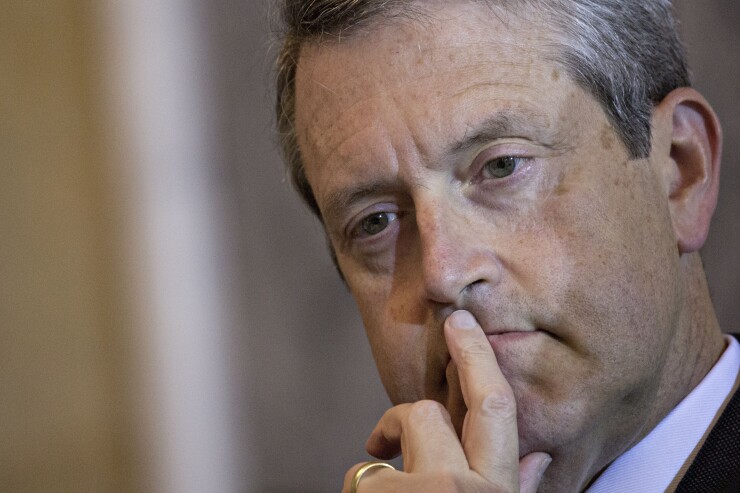WASHINGTON — Federal Reserve Gov. Randal Quarles is stepping down from the central bank at the end of December, giving President Biden another open seat to fill atop the powerful bank regulatory and monetary policy body.
Quarles, a key architect of regulatory relief measures during the Trump administration, said it had “been a great privilege” to work at the Fed and with the global central banking community. He currently serves as the chair of the Financial Stability Board, although his term at the helm of that group ends Dec. 2.
Up until last month, Quarles was the Fed’s vice chair for supervision, the first appointee at the central bank to ever hold that position.
In that role, he oversaw a major policy shift to ease some of the post-crisis regulatory requirements imposed on large banks. That included tailoring capital rules, simplifying the stress test process and implementing a 2018 law that rolled back some provisions of the Dodd-Frank Act.

However, many of the actions he promulgated came under fire from Democrats and financial regulatory advocates who expressed concern that Quarles was weakening post-crisis reforms.
In an interview with American Banker, Quarles said he hoped his legacy at the central bank would be both his work with his colleagues to protect the financial system from the COVID-19 pandemic, as well as his efforts to streamline regulation and supervision.
“When I arrived at the Fed, I set myself the task of saying, we could make the system a lot more efficient without making it any less safe, and I think we did that,” he said. “We made it a lot more efficient, and then COVID came and we had a test that immediately showed that it was not any less safe.”
While he acknowledged that some critics have characterized his agenda as weakening post-crisis regulatory reforms, he noted the strong performance of financial institutions thus far in the pandemic.
“Some folks think that the regulatory changes were too much [and] made the system unsafe, and there are others who were hoping that there would be kind of a much more dramatic Napoleonic conquest,” he said. “I think with respect to the former: did what we do weaken the system? I think COVID shows that that’s obviously not true.”
Still, Quarles will leave the Fed with unfinished business, namely his goal of reforming the Fed’s supervisory regime. In January 2020, he unveiled a comprehensive set of proposals to update how the agency supervises the nation’s banks on an ongoing basis, with the overall goal of bringing more transparency to the existing regime.
But much of that work was dashed a month later when the Fed was forced to confront the pandemic on a full-time basis.
“That project is incomplete,” Quarles said.
He remains hopeful that his successor might pick up where he left off.
“I do think that a consequence of our having drawn attention to it is that a lot more attention is being paid to it. On the left [and] on the right, I think everyone recognizes [that] thinking about due process and supervision is something that we ought to think about,” said Quarles.
With Quarles vacating his seat at the Fed, Biden has another opportunity to appoint someone of his choosing to the central bank. Biden also inherited an open seat from former President Donald Trump, meaning that after Quarles steps down, he will be able to nominate two people to serve at the Fed. Fed Vice Chair Richard Clarida’s term also winds down next year, opening up a third seat if Biden opts against renominating him.
It remains to be seen whom Biden will tap to replace Quarles as vice chair of supervision. Many anticipate that it will be someone with progressive views on bank regulation.
Yet whoever lands in the role may not be entirely focused on rolling back Quarles' agenda, said Isaac Boltansky, director of policy research at BTIG, in a research note.
“Some progressives have called for wholesale changes to Trump-era policy shifts, but we are skeptical given that many of those changes were congressionally-mandated and relatively modest compared to expectations," he said.
Instead, the next vice chair for supervision — along with other Fed nominees — might prefer to focus their attention on climate change, cryptocurrency and modernizing the anti-redlining Community Reinvestment Act, Boltansky said.
Until Biden's choices for the Fed are confirmed, however, few anticipate any major changes to bank regulation or supervision.
“We see no immediate change in bank policy," said Jaret Seiberg, an analyst with Cowen Washington Research Group, in a note. "That will ultimately depend upon whom President Biden picks as the next vice chair of supervision.”
Biden is reportedly close to making a decision on whether to renominate Fed Chair Jerome Powell to the chairmanship of the Fed, as well as whom to appoint as vice chair of supervision. Biden is expected either to re-nominate Powell as chair or elevate Fed Gov. Lael Brainard to the helm of the central bank. Brainard has also been mentioned as a candidate for the vice chair of supervision role.
Before joining the Fed in 2017, Quarles was the managing director of the Cynosure Group, a Utah-based investment firm he founded. Under former President George Bush, Quarles served at the Treasury Department as the undersecretary for domestic finance and as assistant secretary for international affairs.
He also served under former President George H.W. Bush as a special assistant to the Treasury secretary for banking legislation, as well as Treasury deputy assistant secretary for financial institutions.





